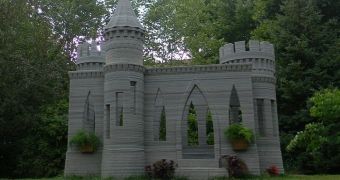Back in July, we brought you news about a man who had begun to 3D print an actual castle out of concrete. Now, we can finally tell you that he has completed that project and is ready to start working on his next one.
However, saying it like that is rather misleading, because the 3D printed castle was not built to scale. Instead, it is more of a playground, sort of, located in the man's backyard.
Then again, Andrey Rudenko was never actually planning to 3D print an actual palace. It's not like the concrete would hold up to the weight.
Also, as good as the concrete 3D printer is, it probably can't maintain the construction perfectly horizontal after a certain point.
Anyway, Rudenko started to build a 3D printed castle back in April, the construction was almost done last month, and now, he has completed the project. This trial run, so to speak. Now, he thinks he is ready to build that 2-story house he was talking about.
Yes, Andrey Rudenko printed a castle as a trial run and considers a home as a greater challenge. The only reason we're not gaping at the absurdity of it is the small size of the “castle.”
There were several obstacles the man had to overcome while creating his chateau. For one thing, the printer's extruder tended to clog pretty often (concrete can dry really fast after all), and there was a time of uncertainty as to how thick and level the layers could be.
Initially, he believed that he would have to stay at a speed of 50 cm a day or less, or 20 inches, but he discovered that he could go beyond that. It took several tries before he figured out exactly how much faster it was safe to move though.
Still, he was eventually able to calibrate the printer properly, which means that he won't have to do the same once he starts on the house. He still reserves the right to play with the layer heights though.
All in all, it's pretty amazing when you consider that the concrete layer height is of just 10 mm / 4 inches, with a width of 30 mm / 12 inches.
Alas, Rudenko won't be able to build the house in Minnesota, as he hoped, because the climate isn't warm and dry enough, or won't be with winter coming on. He is currently looking for a location where the local permitting committee would approve the construction of a 3D printed home. There aren't regulations for this new type of architectural technique in place yet, you see. He hopes those interested will e-mail him with propositions.

 14 DAY TRIAL //
14 DAY TRIAL //